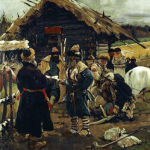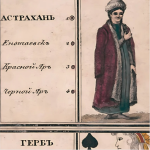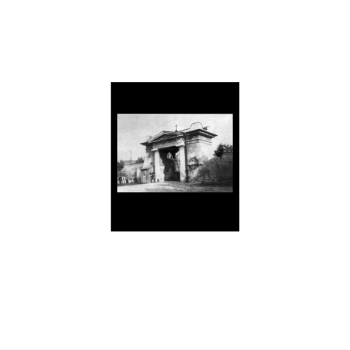SECRET PASSAGES
1835
The Battery was once again on the move, this time stationed in the town of Romankov. It was here that Sasha began to get very sick, dying from a slow chronic illness. The gradual decline of her passionately beloved child forced Helena Andreevna to suffer for months.[1] The early spring of 1835 was very muddy, and the snow was still weeks away from fully melting. The boy got worse every hour, but as no one could ride a horse in the impenetrable mud, it was impossible to send for the doctor. Alone, helpless with a sick child in her arms, without medicine, without a doctor, without the slightest opportunity to alleviate her baby’s suffering, Helena Andreevna lost her head and burst into tears.[2] Sasha began to breathe very heavily during the last hour of his life. The room was very stuffy, so someone advised Helena Andreevna to open the window, assuring her that it would help make it easier for Sasha to breathe. Helena Andreevna, distraught with grief, rushed to open a window for some fresh air. When she did so, a white butterfly flew into it. It fluttered over Sasha’s cradle, landing on the canopy over his head. As if sensing someone’s presence, Sasha suddenly opened his eyes, looked up at the butterfly, took a deep breath, and immediately closed his eyes for the last time. The white butterfly then flew out the window. This strange appearance of a butterfly in the winter, and the calming gaze it cast down upon Sasha at the moment of his death, left a powerful impression on Helena Andreyevna, which deeply affected her superstition and her poetry. “I can’t forget my poor boy and that white butterfly that flew into his cradle, as if on purpose, to carry his soul to heaven on its silvery wings!” Helena Andreyevna would say.[3]
Helena Andreevna’s maternal feelings were cruelly shocked by the loss of Sasha.[4] Her longstanding fear of dead bodies was so powerful, however, that she could not even look at her dead little boy. “This feeling reaches the point of stupidity,” she thought. Helena Andreevna resolved to overcome this feeling in herself. Since they lived outside the village, between the church and the cemetery, she did not let a single dead person pass without looking at them. She went to church when no one was there and looked at their faces. At first, she shook all over her body, and for a long time after that she could not eat anything, but, eventually, she was not so disgusted. “I would still rather want to die such a death that no one would see my body,” she thought, “in a fire, perhaps, for in water they see you puff up like a sponge.”[5]
The dreary town of Romanov, where the Battery stood, had become unbearable. The green mound that replaced Sasha was a cruel daily reminder. With her soul yearning for her family, she and Lelya left the Battery and went to stay with her family in Odessa. While there, she gave birth to her second daughter, Vera in April 1835.[6] Life with her family corresponded to her tastes, upbringing, and needs. Here there were newspapers like The Northern Bee, and the thick magazine, Library For Reading (beloved by the Province,) were published. Although these literary organs belonged to the conservative party that dominated Russia in the 1830s, for the Provinces (which were still mostly indifferent to political life and political convictions,) these publications were important conductors of literary interests and intellectual life in general and awakened something of Helena Andreevna’s literary side.[7] Helena Andreevna met many of these artists and saw glimpses of another world far removed from the drudgery of frontier life.
 “The Last Day of Pompeii.”
“The Last Day of Pompeii.”
The Fadeev family attended many evenings hosted by Mayor Levshin, as Elena Pavlovna was an old acquaintance of his wife, Yelizaveta Fedorovna (née Briskorn.) Another guest one evening was the famous artist of historical, portrait, and genre painting, Karl Pavlovich Bryullov. Russia’s native son was returning home after twelve years abroad. His painting, “The Last Day of Pompeii,” was celebrated for putting Russia on the map in the art world and would serve as inspiration for Edward Bulwer-Lytton’s Last Days Of Pompei.[8] Mayor Levshin greeted Bryullov with a dinner arranged in his honor with many notable people. “Odessa congratulates itself,” said Count Vorontsov at the dinner, “that it is the first of the Russian cities to welcome Bryullov.”[9] The return to his motherland after such a long time gone excited and pleased Bryullov greatly. The hostess, Yelizaveta Fedorovna, invited young Katya Andreevna to sing a Russian song. Katya, who had a remarkably good voice, pleasantly cultivated, sat down at the piano and, accompanying herself, sang a Russian folk song. Bryullov was so moved that he began to cry and, bursting into tears, rushed to kiss her hands. Then Yelizaveta Fedorovna herself sang, and Katya, at her request, was invited back up to sing Russian and Little Russian songs. Bryullov was beyond delighted the whole time.
That summer (1835) another interesting thing occurred. It happened that Andrei Mikhailovich was walking down the street one day when he accidentally met the solemn funeral procession of one of the most remarkable inhabitants of the city, Count Pyotr Alekseevich Razumovsky.[10] The story, as it was related to Andrei Mikhailovich, went something like this: For a long time, he had lived in Odessa as a complete recluse, ceasing almost all personal relations with the world. They said that in his youth he was a very sociable, cheerful person, traveled a lot, and lived abroad for quite some time. In Paris he led a carefree life, spending a lot of money. Exceeding the monthly allowance given to him by his father, he incurred a great deal of debt. His strict and not very tender father bought up his bills and put his son in debtor’s prison. Count Razumovsky remained imprisoned for two years. The death of his father freed him from his shameful cage and at the same time made him one of the wealthiest men in Russia. The young Count Razumovsky was not the same man who entered prison, however, devolving from a lively and worldly man into a gloomy and suspicious hypochondriac.
For whatever reason he chose Odessa as his place of residence and bought some land just outside the city. He planted a magnificent garden, in the middle of which he built a house of the most unique architecture. When building the house, Count Razumovsky brought in the best artists from Italy, and other places from Europe for the interior decoration (sculptural decorations, murals on the walls and ceilings, etc.) He filled the house with all the treasure of the ancient and modern art that his wealth could provide him with and, having grown a long beard (which no one except the common people wore at the time) and hair, he locked himself in without leaving, never going out, and never receiving anyone (with few exceptions.)
Beneath the house, Count Razumovsky arranged for the construction of a vast, subterranean labyrinth (some called it a dungeon,) with endless corridors and passages in various directions. The only entrance to this mysterious lair was behind a secret door in Count Razumovsky’s bedroom. The key to this maze was known only to him. In 1828, during the Turkish War, Tsarina Alexandra Feodorovna, staying in Odessa at the time, had learned about the extraordinary decorations of Count Razumovsky’s house, and his rare collection of art and antiquities, wished to see them and sent to tell Count Razumovsky that she would visit him at the appointed hours and day. The Count gave a reception quite worthy of an august guest, prepared a magnificent breakfast with refreshments and that day, several hours before the Tsarina’s arrival, he went into his labyrinth, where he sat, hidden, until late at night. This unexpected trick puzzled everyone so much that it remained in the memory of Odessa residents for a long time.
After Count Razumovsky’s death, his heirs in the collateral line treated the property he left in Odessa with incomprehensible negligence; none of them even bothered to come see what was left behind. In absentia, they ordered everything to be sold en masse at public auction. This sale lasted a long time (since it was not easy managing a mass of heterogeneous things.) They were sold in batches, by departments. Many people went (if only to see the curiosities,) including Andrei Mikhailovich and Elena Pavlovna. Everyone looked with pity at the precious collections of paintings, statues, weapons, and all sorts of rarities, that were acquired with huge amounts of money. Everything was sold for next to nothing. During the sale of furniture, among many luxurious, elegant things, there was a simple, most ordinary chess table, which did not attract anyone’s attention due to its inconspicuousness. When it was up for auction two men whom the Count often invited to play chess with, and the Italian and a Frenchman, came up to bargain. They declared that they wished to buy the table solely as a keepsake of the late Count, and the price began to rise little by little. The price soon reached such serious proportions that it aroused general astonishment. Finally, one of the men retreated, and the other, having taken possession of the table, tried to pay and carry it away. It turned out that there was a secret compartment in the table and in it a precious ancient chess set, of extraordinary craftsmanship, fashioned from coral and amethyst. No one knew about this except the two partners of the Count. The house was also sold at auction, but did not long survive its owner, and soon burned to the ground.
Life in Odessa flashed by like a dream. By the end of 1835, Helena Andreevna had to return to her husband and the military camp life. Packing her things, she said goodbye to her family. It was the first time that Pyotr Alekseevich met Vera, and there was much joy on the occasion. Soon the family and the Battery were traveling throughout the Provinces of Tula and Kursk.[11]
-
- NOVOROSSIYA
- The Arbiter Of Europe’s Destiny.
- The House Dolgorukuy
- Madame Krüdener
- Ekaterinoslav
- The Arabat Arrow
- The Mystery Of General Inzov
- The Doukhobors
- Pushkin
- Chuguev Military Settlement
- “The Blessed”
- The Decembrists
- Penza
- Independence
- Last Words Of Samuel Khristianovich Kontenius
- “Amid Coffins And Desolation”
- Rusalka
- Dead Souls
- Secret Passages
- Astrakhan
- Nevsky Prospekt
- Kalmyk Ulus
- Love And Ambition
- Duellistes
- Pyatigorsk
- A Heroine Of Our Time
- Winter Palace
- Zeneida R-Va
- Steppes
- Letter To Natalya
- Fire And Ice
SOURCES:
[1] Zhelikhovskaya, Vera Petrovna. “Helena Andreyevna Hahn (1835-1842.)” Russkaia Starina. Vol. LII, No. 3 (March 1887): 733-766.
[2] Nekrasova, E. S. “Helena Andreyevna Hahn (1814-1842): Part I.” Russkaia Starina. Vol. LI, No. 8 (August 1886): 335-354.
[3] Zhelihovskaya, Vera Petrovna. My Childhood. A. F. Devrien. St. Petersburg, Russia. (1893.) [Preparation of the text and comments by A.D. Tyurikov. Bahmut Roerich Center; Zhelihovskaya, Vera Petrovna. “Helena Andreyevna Hahn, Zeneida R-va.” (1885.) [Preparation of the text and comments by A.D. Tyurikov. Bahmut Roerich Center.
[4] Zhelikhovskaya, Vera Petrovna. “Helena Andreyevna Hahn (1835-1842.)” Russkaia Starina. Vol. LII, No. 3 (March 1887): 733-766.
[5] “Letter From E. A. Hahn To Natalya P. Dated January 10, 1839. [Kamenskoye Village, Ekaterinoslav Province.” [Preparation of the text and comments by A.D. Tyurikov. Bahmut Roerich Center. Originally published in: Gershenzon, M.O. “Russian Woman Of The ‘30s.” Russian Thought. Vol. XII, C. 55 (December 1911.)]
[6] Johnston, Charles. “Madame Blavatsky’s Forbears.” The Theosophical Quarterly. Vol. XXX, No. 1 (July 1932): 12-16.
[7] Nekrasova, E. S. “Helena Andreyevna Hahn (1814-1842): Part I.” Russkaia Starina. Vol. LI, No. 8 (August 1886): 335-354.
[8] Vance, Norman. The Victorians And Ancient Rome. John Wiley & Sons. Hoboken, New Jersey. (1997): 47.
[9] “Soon after Bryullov finished Pompeii, laudatory reviews of it, translated from foreign publications, began to appear in Russian magazines; to this were added enthusiastic reviews from Russian tourists who had the opportunity to see the painting in Italy. The fame of the painting and its author, long before his arrival in Russia, had spread not only in St. Petersburg and Moscow, but also in the provinces. Immediately after the closing of the Paris exhibition, Pompeii was sent to Russia and at the end of the summer of 1835 it arrived in St. Petersburg, where Demidov presented it to the Emperor (‘I have often regretted, my dear Bryullov,’ Demidov wrote to Bryullov many years later, ‘that my patriotism inspired me with the idea of parting with this beautiful work of art, which is missing to decorate San Donato.’) At the request of the Emperor, Pompeii was first exhibited in one of the halls of the Winter Palace, and then in the Academy of Arts, to which the Emperor bestowed this painting. Whole crowds of visitors came to admire Bryullov’s works, some came from the provinces especially for this purpose. At the Academy of Arts, the members of the council ‘considered that the painting by the artist Karl Bryullov, a former student of the Academy and a pensioner of the Society for the Encouragement of Artists, The Last Day of Pompeii, which gained him fame in Italy and was crowned with the Academy of Arts in Paris, has indisputably the greatest merits, placing it among the extraordinary artistic creations of our time in Europe, and therefore the council of the Imperial Academy of Arts considers it just and considers itself obliged to show K. Bryullov a special sign of its respect for his high talents and art’; This ‘expression of respect’ was expressed in the election of Bryullov as an honorary free member of the academy and in the academy’s petition (unsatisfied) to elevate Bryullov to the rank of professor without fulfilling the program and other obligations established by the rules. Emperor Nicholas I, who followed the successes of Russian art and always patronized it, gave orders for the immediate summoning of Bryullov to St. Petersburg to take up a professorship at the Academy of Arts. This invitation found Bryullov in Constantinople. He immediately got ready for the journey and went first to Moscow via Odessa. In Odessa, the residents greeted Bryullov with a dinner arranged in his honor; ‘Odessa congratulates itself,’ Count Vorontsov said at this dinner, ‘that it is the first of the Russian cities to welcome Bryullov.’” [Polovtsov, A. A. Russian Biographical Dictionary. Vol. III: Betancourt—Byakster. Imperial Russian Historical Society. St. Petersburg, Russia. (1908): 401–411.]
[10] “[Count Pyotr Alekseevich Razumovsky,] chamberlain, the eldest son of Count Alexei Kirillovich and his wife Varvara Petrovna, née Countess Sheremeteva; born in 1775 and spent the early years of his childhood in his parents’ house, being enlisted in 1783 as a sergeant in the Life Guards in the Izmailovsky Regiment. Later, in the 1790s, he was sent abroad under the supervision of a certain Shel, who developed in him a passion for everything French. In 1793, the young count studied in Göttingen, where at that time many of his compatriots attended lectures and where there was even a Russian club, consisting mainly of barons from the Baltic region. In Göttingen, he attended lectures on politics, rhetoric and Russian history by Schlözer, to whom he was recommended by his father, who had once been a student of the same Schlözer; the latter now supervised his son’s studies. Young Razumovsky returned from abroad in 1795, having been promoted to ensign in 1793. He was now appointed adjutant to his grandfather, Hetman Count Kirill Grigorievich, who doted on his grandson. The decree of Emperor Paul I on the abolition of the military staffs of field marshals not on active service forced the young Count P. A. Razumovsky to join the front in 1797: he was renamed lieutenant colonel and enrolled in the Astrakhan Grenadier Regiment, and then, in 1798, on May 25, he was promoted to colonel and appointed commander of a combined grenadier battalion and served in the army of his uncle, Infantry General Ivan Vasilyevich Gudovich. At the beginning of Suvorov’s famous Italian campaign, this army was supposed to reinforce the troops that had advanced abroad.—On August 1, 1799, Razumovsky was promoted to major general and appointed chief of the Old Ingermanland Musketeer Regiment (formerly Steingel), and 6 months later he was expelled from service for detaching, contrary to all regulations, Staff Captain Lang to the provisions commission. However, 8 months later he was accepted back into service and appointed to the regiment and battalion of His Imperial Majesty Nikolai Pavlovich (now the Life Guards Izmailovsky Regiment). He received a lot of money from his parents and grandfather but was always in debt; when the regiment surrendered, he also had to pay a lot extra. On May 15, 1801, R. was granted the rank of actual chamberlain and excluded from the regiment and from the generals’ list. He settled in Petersburg, began to live with his younger brother Kirill and ran up a lot of debt in Petersburg; The latter prompted his father, Count Alexei Kirillovich, to seek his son’s transfer to serve in Odessa, to the Governor-General, Duke Richelieu. This did not please the young Count: he was afraid of boredom in a distant place. Nevertheless, he was appointed, with the rank of chamberlain and actual state councilor, an official on special assignments to the Novorossiysk governor (1806). He was not averse to intellectual pursuits and was quick to acquire for himself a magnificent library in Odessa, which was sold at auction after his death. Count R. died in 1835 and was buried in the Odessa cemetery. With him, the line of Counts Razumovsky ended in Russia.”[Polovtsov, A. A. Russian Biographical Dictionary. Vol. XV: Prittwitz-Reis. Imperial Academy of Sciences. St. Petersburg, Russia. (1910): 468-469.]
[11] Fadeyev, Andrei Mikhailovich. Vospominaniia: 1790-1867. Vysochaishe Utverzhd. Yuzhno-Russkago. Odessa, Ukraine. [Russian Empire.] (1897): Part I: 110-114.













